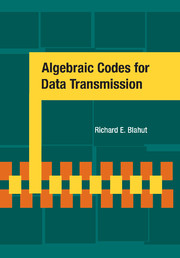Book contents
- Frontmatter
- Contents
- Preface
- Dedication
- 1 Introduction
- 2 Introduction to Algebra
- 3 Linear Block Codes
- 4 The Arithmetic of Galois Fields
- 5 Cyclic Codes
- 6 Codes Based on the Fourier Transform
- 7 Algorithms Based on the Fourier Transform
- 8 Implementation
- 9 Convolutional Codes
- 10 Beyond BCH Codes
- 11 Codes and Algorithms Based on Graphs
- 12 Performance of Error-Control Codes
- 13 Codes and Algorithms for Majority Decoding
- Bibliography
- Index
9 - Convolutional Codes
Published online by Cambridge University Press: 05 June 2012
- Frontmatter
- Contents
- Preface
- Dedication
- 1 Introduction
- 2 Introduction to Algebra
- 3 Linear Block Codes
- 4 The Arithmetic of Galois Fields
- 5 Cyclic Codes
- 6 Codes Based on the Fourier Transform
- 7 Algorithms Based on the Fourier Transform
- 8 Implementation
- 9 Convolutional Codes
- 10 Beyond BCH Codes
- 11 Codes and Algorithms Based on Graphs
- 12 Performance of Error-Control Codes
- 13 Codes and Algorithms for Majority Decoding
- Bibliography
- Index
Summary
To encode an infinite stream of data symbols with a block code, the datastream is broken into blocks, each of k data symbols, called datawords. The block code encodes each block of k data symbols into a block of n code symbols, called a codeword. The codewords are concatenated to form an infinite stream of code symbols.
In contrast to a block code is a trellis code. A trellis code also encodes a stream of data symbols into a stream of code symbols. A trellis code divides the datastream into blocks of length k, called dataframes, which are usually much smaller and are encoded into blocks of length n, called codeframes. In both cases, block codes and trellis codes, the datastream is broken into a sequence of blocks or frames, as is the codestream. When using a block code, a single block of the codestream depends only on a single block of the datastream, whereas when using a trellis code, a single frame of the codestream depends on multiple frames of the datastream.
The most important trellis codes are those known as convolutional codes. Convolutional codes are trellis codes that satisfy certain additional linearity and time-invariance properties. Although we introduce the general notion of a trellis code, we will be concerned mostly with the special class of convolutional codes.
Information
- Type
- Chapter
- Information
- Algebraic Codes for Data Transmission , pp. 270 - 312Publisher: Cambridge University PressPrint publication year: 2003
